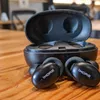The Pebble Twins Stereo Earpods are affordable, but your ears deserve better
Pebble Twins Stereo Earpods are priced at just Rs 2,990, but can the ‘deep bass wireless earpods’ stand out in a crowded market?
The global market for true wireless hearables reached 27 million units in Q2 2019, growing 56 percent quarter on quarter.
And though Apple continued to rule the roost, its market share fell due to the growth of the second-tier players. Even as Samsung, Jabra, Bose, and Xiaomi slug it out, the market has seen a plethora of affordable offerings, including the Realme Buds Air.
Affordability may give you a distinct advantage, especially in a price-conscious market such as India. And Pebble Twins Stereo Earpods aim to cash in on that advantage.
Pebble launched the Twins Stereo Earpods at just Rs 2,990, about Rs 1,000 cheaper than the Realme Buds Air.

Are the Pebble Twins Stereo Earpods a good competitor, on their own and in a head-to-head battle with the Realme Buds Air, currently the most popular pair of budget True Wireless Stereo (TWS) earphones?
Can the Pebble “deep bass wireless earpods” stand out in a crowded market?
Let’s find out.
The Pebble Twins Stereo Earpods come with IPX54 protection, which makes them water and dust-resistant. Many TWS earphones skip out on any sort of IP rating - a disappointment as these are meant to be used inside and outside the house.
Chunky, but not too unwieldy
The Pebble Twins seem chunky. Compared to the Jabra Elite 75T’s, Samsung Galaxy Buds, and Realme Buds Air, they are huge. But when compared to the TicPods Free, they aren’t too unwieldy.
The case design makes them sturdy. It doesn’t open or close with a flick or a slide; there is a physical release button one must press to open the case and fish out the earpods. But it must be said that the case doesn’t feel premium at all.

The lack of battery indicators is noticeable. The earpods light up to indicate what “mode” they’re in, and whether they have charge or not.
The fit feels a little odd. The earpods settle into the ears comfortably, but protrude. That’s a concern, especially if you’re on the move a lot - walking, jogging, or running. However, they almost never fall out. You may get tired of wearing them, hour after hour, because of the way they fit, and may need to take breaks.
The company offers replacement ear tips - two pairs - in the box to find the “perfect fit”. It would have been good to have more sizes, but this is a budget TWS pair of earphones.
One good feature is that the Pebble Twins let you listen to music through either the left earbud or the right, or both.
Sound quality: leaves a lot to be desired
Turning the Pebble Twins on leads to the realisation that they are loud; louder than any of the TWS earphones I’ve reviewed in the past couple of months. At those high volumes - past the 75 percent marker - there is a lot of distortion. It feels like there’s a lot of background noise when there actually isn’t any.
The Pebble Twins are advertised as “deep bass wireless earpods”, and that’s where they excel the most. One can feel the beat reverberate inside the ears like with no other earpods in this price range.
Vocal clarity is a problem. While testing a couple of instrument-heavy songs and dance-floor pop songs, you’ll notice that the vocals tend to blend in with the instruments. Figuring out the lyrics can be a struggle.
Having said that, during softer jazz/blues songs, it’s possible to figure out how many instruments were featured in the songs. The Pebble Twins are a delight for mellow songs.

The Pebble Twins have a v-shaped soundstage. A ‘V’ curve is one with an enhanced bass and treble frequencies; it’s supposed to make audio sound loud and crisp. The former is achieved, but the latter leaves a lot to be desired.
It’s a shame because these earpods actually have so much potential.
The case for physical buttons
Yes, the Pebble Twins feature a button on each earbud. They are hard to press, and, when pressed, push the earbuds further into your ear, making them really uncomfortable.
The button functionality is straightforward. A double press on the right earbud to change to the next song. The same on the left will go to the previous song. A triple click to adjust the volume - higher or lower.
Call quality doesn’t pass the test
The Pebble Twins falter the most when it comes to calls. They are not designed for taking calls despite the 10mm drivers on both the earbuds and the noise cancellation feature.

I tried calling on my walk home from the metro (with good signal) and calling early in the morning using VoWiFi (a feature designed to enhance the call quality). But I was forced to disconnect both times to be able to clearly hear the person on the other side of the call.
Long-lasting, but why the micro-USB port?
Pebble claims that its earpods are capable of delivering 25 hours of non-stop playback. They went for about 18-20 hours on a single charge with 50 percent volume and while playing music on loop.
It’s 2020, and manufacturers are still delivering products with micro-USB ports. It was expected that 2019 would bring the last of them as the world moved on to Type-C connectivity, but that hasn’t happened.
The Pebble Twins come with an outdated micro-USB port for charging, and it isn’t particularly fast.
Connectivity: keep the connected device close
The Pebble Twins have a range of just 10 meters. That isn’t a lot.
Connecting the Pebble Twins to a smartphone or tablet is straightforward and works without any glitches. The problem arises while listening to songs for long durations. One noticed a drop in connectivity for a few seconds once every half hour or so. It’s not a deal breaker, but it is certainly annoying.

Are the Pebble Twins worth a buy?
The Pebble Twins, at Rs 2,990, are a good deal. They’re a much better purchase than the Realme Buds Air, but if you’re willing to spend a couple of thousand rupees more, there are plenty of options that are far superior.
The Rs 5,000 and under TWS earphones segment is rapidly growing with many more brands like Pebble, Realme, and pTron releasing products.
The Pebble Twins may be one of the better options, but it would have been great if they were available in a less bulkier case.
(Edited by Teja Lele Desai)










